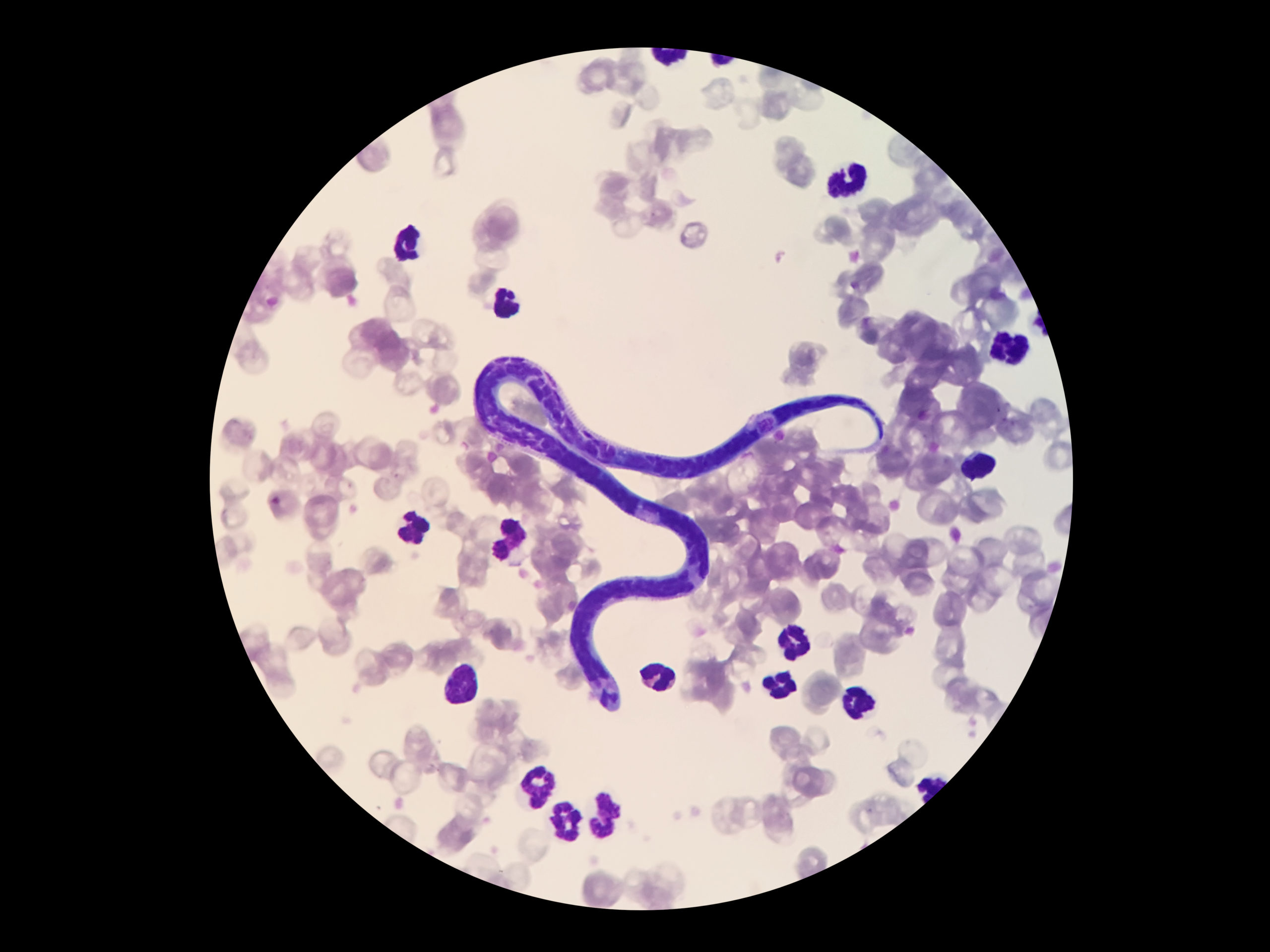The Heart of the Pest Problem: The Facts About Heartworms
The Heart of the Pest Problem: The Facts About Heartworms
The scariest pests are arguably the ones that we don’t see until they have already done some kind of damage, either to our homes or to our bodies. If you were to research every parasite and what they can do, it might cause you to never want to venture outside again. But since most of them can be easily avoided by not going into wild areas that should not be inhabited anyway, there is no reason to fear these parasites when going for a walk in your suburban neighborhood. However, one of the most common parasitic creature that you have likely heard of in everyday life is unfortunately capable of invading anywhere: the heartworm. This roundworm is almost always associated with dogs, and for good reason that we’ll discuss later, but what does a heartworm even do in a dog’s body? This is the question that we will explore in order to better understand this pesky parasite.
What are Heartworms?

Heartworms are some of the strangest looking worms out there, but they are also very dangerous to the health of their hosts. They are parasitic worms that look like long strands of spaghetti and live out their whole life cycle inside a dog. Heartworms, also known as Dirofilaria immitis, now exist everywhere in the U.S. but are still the most common in the Southeast. Heartworms can live to about five to seven years, most of which would be spent in a dog’s intestines. The adults live in a dog’s lungs, heart, and associated blood vessels, which all mean that they can cause extreme damage to the dog if they are unnoticed long enough.
If heartworms go undetected so often and only seem to really affect dogs and some cats, how do they even spread? The good news is that heartworms aren’t contagious and can’t be spread through the air or by being near a dog that has them. The bad news is that they are carried by one of the most annoying and common pests: mosquitoes. The mosquito becomes the immediate host when it bites an infected dog and the larvae goes into the mosquito’s gut, where it will develop for 10 to 14 days. The mosquito will then transfer it into whatever mammal it bites, which is how a different dog gets the heartworms. This sounds like yet another awful thing that can come out of a mosquito bite for us, with common company in the likes of malaria and yellow fever, but the one positive of heartworms is that they can’t survive in humans. Even if an infected mosquito bites us, the heartworm larvae would die before it could do anything to our hearts. So it’s really only our pets that are in danger of contracting these worms from a bite, but the outcome of being infected is one that every pet owner fears.
Heartworm Disease

Heartworm disease is the formal term for when a dog has heartworms living inside of its body. Basically, the mosquito gets the heartworm larvae (microfilariae) from an infected dog’s bloodstream, the larvae becomes infective by developing inside the mosquito, and the mosquito injects the larvae into the next dog it bites after the larvae develops more. This is why heartworms are more commonly discussed in the peak of mosquito season during the warmer months. While every dog is susceptible to heartworms in some capacity, dogs ranging from 2 to 8 years old seem to be the favorite hosts for the parasites. The number of worms in a dog, or the worm burden, can be anywhere from 1 to 250 depending on the size of the dog and the amount of time that they go undetected. It takes about 6 to 7 months for the heartworms to fully mature and be able to reproduce, meaning that they can live in a dog for a long time before anyone notices. Male heartworms are about 4 to 6 inches in length, while females are 10 to 12 inches. That is an uncomfortably long worm to be anywhere inside a being, which is why a pet that has them is visibly unwell. But more on that later.
You may notice that we keep using dogs as the host of heartworms, rather than just sticking to pets in general. This is because while cats can get heartworms, it is far less common than dogs. The worms don’t typically survive in cats due to their different internal structure, and there aren’t as many infective worms anyway. They are more difficult to detect in cats even with the small number, but this is dangerous because of the worms’ fatality in themselves. If the worms die within the cat, they release toxins that can eventually be lethal to the cat if nothing is done. Although cats are not as vulnerable to heartworms as dogs, it is still important to have the vet test for heartworms and discuss prevention methods, just to be on the safe side. The most common carriers of heartworm disease are stray dogs and wild mammals, like wolves and coyotes, but domesticated pets should still be protected against this fatal pest.
Pet Symptoms of Heartworm Disease

Besides getting your pet checked for heartworms at the vet, heartworms are most frequently found through the physical symptoms of the pet host. As mentioned earlier, the severity and amount of the symptoms depends heavily on the length of infection, quantity of the worm burden, and size and age of the dog. There are four distinct stages of symptoms that increase as time goes on without treatment. While there can certainly be some overlap and specific severity depending on the case, these tend to be the most commonly seen symptoms:
- The first stage is the beginning of the invasion, and is therefore the most mild. There will likely be no symptoms since the worms are still maturing. If anything, a mild cough could be the symptom that can clue you in to something strange happening with your dog.
- The second stage is slightly worse, but still nothing too extreme. The cough will be more noticeable and frequent. If you’ve ever heard a dog cough, you know it is very distinct from the other random noises they make while playing or eating. Your dog may also experience fatigue and seem to take less of an interest in its usual favorite activities.
- The next stage is a major jump to more extreme and concerning symptoms. The cough and fatigue continue to worsen, and the dog will be visibly unwell. Just like how humans look sickly when we get a bad cold or other virus, dogs also look how they feel. They will also have more trouble breathing in this stage, likely because the worms have spread to their lungs. Inside, the dog may have an early form of heart failure, making this stage a crucial one in getting treatment as soon as possible.
- The final stage is definitely the worst, and hopefully the heartworms are treated long before it gets to this point. It is also known as caval syndrome and can be fatal if it’s not immediately treated. Basically, the worm burden is now a huge mass and is blocking blood flow to the heart, which is clearly not a healthy sign. The only way to treat this stage is through surgery, which is already a risky procedure due to the depleted health of the dog.
In short, it is crucial to get your dog into the vet ASAP if they start showing any kind of symptom. Even if it turns out not to be heartworms, your vet will be able to find out the true problem and the most effective treatments. Also, if your pet has heartworms, it is not a sign that you have a “dirty” home or are a bad pet owner. This is a universal problem for dogs because of those frustrating mosquitoes, so all we can do is look out for our furry friends and get them the help they need as soon as we can.
Common Tests & Treatments

In general, heartworm treatment is unfortunately very expensive and could be risky depending on the overall health of your dog. But to many families, the health of a beloved pet is priceless and will be understandably preserved at all costs. The first step of many treatments is to test for heartworms, to see how many there are and what kind of damage they have already done. Testing can also be done at your or the vet’s request if your pet is showing symptoms. Some pet insurance covers a good chunk of the testing, so you may want to look at the details of your insurance if this applies. The most popular tests are blood tests and antigen tests. Since the females release the offspring in the dog’s blood, both of these tests are designed to catch them before it’s too late. There is also a test for the microfilariae if it seems that they have already set up shop inside.
Since heartworm larvae is released about 5 to 6 months after the original mosquito bite, they may not show up on exams or tests originally. But testing is still a very important part of your pet’s health, especially if there are surrounding circumstances that seem to favor a heartworm invasion. These include your pet traveling to a new place, lack of heartworm prevention, or a skipped month of prevention. Regardless of the circumstances, it’s a good idea to keep an eye on your dog and take note of any strange symptoms that could be a sign of a serious problem, even if it’s not heartworms.
As for treatments, they are a last-resort option due to the adverse effects that can come of them. Treatments are not a guarantee that everything will be great once the heartworms are gone, as complications can arise due to your dog’s health. They are also very expensive, and are not always covered by pet insurance. The most common treatment is an injection of some kind, the most well-known being Immiticide and Diroban. If your pet tests positive for heartworms, make sure that it does not exercise before treatment. The more active the pet, the more internal damage will be done. This also applies to the time after the treatment is over; your dog will need plenty of rest afterwards while its body fights the heartworms and takes in the treatment. Treatments have come a long way with the advancement of medicine, but the most ideal way to treat heartworms is to prevent them in the first place in order to preserve the health of your dog.
Prevention is the Best

With heart worms, prevention is the easiest and most effective method for both you and your pets. While there is some cost involved, as with most precautions in life, it is not nearly as much as a treatment would be. The most common heartworm prevention is an oral tablet that is prescribed by the vet. Many dogs actually like to eat this tablet, so it’s not difficult to give it to them once a month. If your dog doesn’t seem to enjoy this monthly treat, you could try sneaking it into their food. Just make sure that they actually consume it and don’t spit it out! Another common prevention product is a topical liquid applied to their skin. Ask your vet which method they think would be best for your beloved dog and their medical history.
There is usually some form of heartworm test done at the annual exam, but you can always confirm with your vet. An injection that prevents heartworms from entering the bloodstream is also commonly given about once a year, and this is one of the most effective ways to prevent them. You can always check with your vet to make sure that there isn’t any early signs of heartworms, but prevention methods should already be in place for any dog over 7 months old in order for them to live their best heartworm-free life.
The most mutually beneficial way to prevent heartworms in the first place is to eradicate the mosquito problem. Mosquitoes are not only the carriers of heartworms, they also can be potentially carrying yellow fever, malaria, and other dangerous diseases! Even if the bite doesn’t result in more than an itchy bump, it’s still an annoying experience that makes going outside a chore. Our team of experienced technicians knows the most effective ways to treat mosquitoes and prevent them from invading your yard. Contact our team at any time to learn more about how we can eradicate your mosquito problem and create a safe yard for you and your furry friends.
Citations
Barnette, C. (DVM) & Ward, E. (DVM). (n.d.). Heartworm disease in dogs. VCA Animal Hospitals. Available at https://vcahospitals.com/know-your-pet/heartworm-disease-in-dogs (Accessed on June 21, 2022).
Heartworm basics. (n.d.). American Heartworm Society. Retrieved June 21, 2022, from https://www.heartwormsociety.org/pet-owner-resources/heartworm-basics
Keep the worms out of your pet’s heart! The facts about heartworm disease. (2019, August 22). U.S. Food & Drug Administration. Retrieved June 21, 2022, from https://www.fda.gov/animal-veterinary/animal-health-literacy/keep-worms-out-your-pets-heart-facts-about-heartworm-disease

